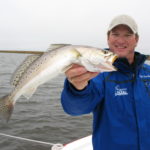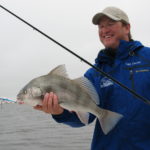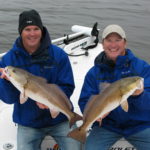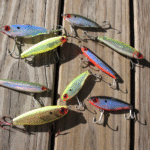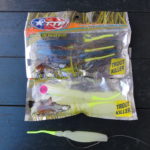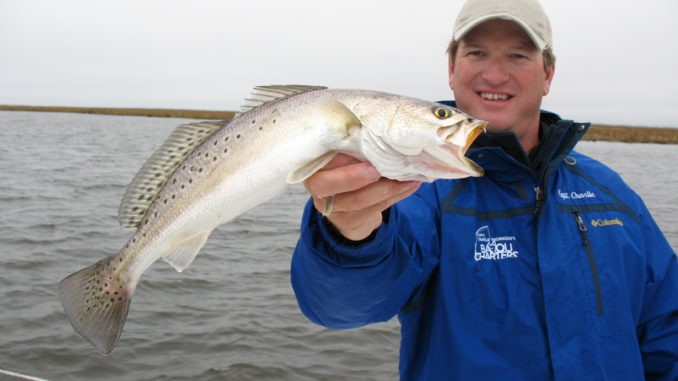
Don’t let cold fronts dissuade you from fishing shallow water for speckled trout.
If I were a betting man, I’d be willing to bet that when Capt.Charlie Thomason was a kid, he was always in trouble. I picture him as the mischievous type, cutting up in class, constantly talking and generally disruptive. Not in any menacing, criminal sense, mind you, but the type of kid who is perpetually antsy, unable to sit quietly, clowning and talking up a storm — the kind of kid who likes to color outside the lines.
I figure he was like that because that still pretty much describes him — still antsy, still talking, still coloring outside the lines and still breaking the rules (Charlie once confided in me that he couldn’t go deer hunting because it’d require him to sit still and be quiet for hours on end, which he considered impossible).
But it’s that very penchant for coloring outside the lines and breaking the rules that often produces exceptional results.
Everyone knows there are certain unwritten rules to a successful fishing trip. We can call them guidelines, and anglers are ready to recite them as excuses for unsuccessful trips.
For instance, “You can’t fish right after a front,” is a well-known angler’s adage. Common sense says to give it a day or two to calm down, let the weather moderate and then go spank the fish. And it’s a good rule of thumb.
The rules are there because they’re tried-and-true. They work. As do other such guidelines, like avoiding a west wind (when fishing the east side of the river), fishing deep on cold days and choosing to fish on days when the wind isn’t blowing a gale.
And then there’s people like Thomason who insists on coloring outside the lines and breaking the rules.
I called him recently to confirm our trip for the next day, but I knew it was just a formality. The trip would definitely be postponed. The forecast was for really cold temperatures, rain and blustery west winds. A no-brainer, I figured. But I figured wrong. Thomason said the trip was on, and that despite the horrible conditions, we’d catch fish.
And that’s how we wound up early the next morning, before sunup, sitting in his truck to stay warm, hoping the rain would stop so we could go fishing. And I admit, maybe I was hoping the rain wouldn’t stop so I could just go home and stay warm and dry. The prospect of a frigid, wet boat ride wasn’t at all enticing. But I did come prepared, and once dressed in all my duck-hunting gear, I was ready to go fishing.
Thankfully, the boat ride to our first stop wasn’t all that long, and the rain had dwindled to something more akin to a mist than anything else, and we soon pulled close to a shoreline in a shallow bay. Thomason dropped the trolling motor, began slowly working along the edge of the bank and suggested we cast our baits out toward the open water.
We had Capt. Joe Vinson along with us, who has about 6 years of experience guiding with Thomason, and the three of us began casting baits. Thomason and Joe were tossing hard baits — slow-sinking MirrOlures — while I tossed a glow DOA shrimp under a cork. I did find it odd that on such a cold day we weren’t parked over a deep hole in the turn of a bayou or at a deep cut somewhere, but Thomason insisted this shallow shoreline would be productive.
It wasn’t.
We trolled it for 15 minutes or so, them casting their baits, me popping my cork and thinking of all the reasons why fishing shallow on a frigid day is generally a dumb idea. But I’ve fished with guides long enough to know that these guys have a fish-finding savvy that can be almost uncanny. They somehow manage to find fish when the rest of us struggle. I attribute it to the fact that they’re on the water a lot more than the average angler, and that enables them to kind of keep track of where the fish are. Plus they share information to keep each other in the loop, and they’ve made fishing more than a pastime. They study conditions and patterns, and they know the areas that produce under the particular conditions they face each day. That has to be the reason for their success. I refuse to believe that they have some kind of fish-whisperer super-power (but I could possibly be wrong about that).
So we picked up and moved to another shallow bay where we caught a redfish, and when nothing else wanted to cooperate, we moved again just a bit farther up into a series of no-name ponds. They looked fine for hunting ducks and probably reds, but we were there looking for speckled trout.
And we found them! The trout were there in that shallow water on a cold day, hitting hard baits and soft plastics under a cork.
Breaking the rules
“What you want to do is fish along the northern edge of the bank, because the prevailing winds this time of year will be out of the north, and that will have you fishing on the lee side, so you can cast toward the middle with the wind at your back,” said Thomason. “Plus, you want to fish the bodies of water with an oyster bottom because that’s where the cleanest and warmest water will be.”
The logic is that just as stone and cement (such as a street or parking lot) will hold heat longer than a surrounding grassy area, so a shallow bay or pond with an oyster bottom will hold heat longer than a soft bottom. And the bonus is the oysters not only filter the water, but their very presence makes the bottom less prone to muddy up on a windy day.
“You’ll want to stay off the bank anywhere from 40 to 50 feet, and at times I venture farther off the bank than that, up to 100 feet or more, and troll parallel to the shoreline so you can cast out toward the middle, perpendicular to the bank,” he said. “The fish are not usually right against the bank this time of year. They’re hanging just along the drops and ledges and patrolling along those ridges looking for prey.”
We reeled in several nice trout, probably a bit larger than the usual wintertime trout, and we worked the area over pretty thoroughly. Thomason stayed with the hard baits, switching occasionally from slow-sinkers to suspending, while I worked the plastic under a cork. We both had success, and Thomason stuck the power-pole to see if we could stay with the action for a while.
Meanwhile, Vinson decided to pull out all stops and dipped into the bait well for some Campo’s live shrimp and gave that a try. He got an instant hookup with a sizeable speck.
“He hit it like it was springtime,” Vinson said, as he swung the fish aboard.
When two more casts landed him two more trout, I pulled off the plastic and went with the live shrimp also.
“Look around and tell me, do you see any other boats out here?” Thomason questioned. “There are probably people fishing, but they’re in the bayous parked at the deep holes fishing soft plastics dead on the bottom. Doing the typical wintertime fishing,” he said, answering himself. “And that’s OK because the holes do concentrate fish on cold days, but they also concentrate fishermen, and that can get crazy sometimes.
“My thinking is, why not color outside the lines, break the rules and fish areas everybody else overlooks on cold days? The fact is, these areas we’re fishing will usually hold bigger fish than the holes do.”
And we were proving his theory by landing trout after trout, with a few reds and black drum thrown into the mix. None of these were huge fish, as winter trout seldom are, but they were certainly better than the typical size you get in the deep holes. And a lot of them were hitting the hard baits that Thomason kept tossing, which is atypical for winter fishing.
“It’s not that the trout won’t hit these baits because obviously they do, but not many people use them anymore, especially not in winter,” said Thomason. “But you can catch fish on them all year round.
“I even fish topwater baits in the winter, especially just before a front blows through, before the winds kick up. If you throw a topwater bait along the windy shoreline under those conditions, you will be surprised at the quality fish you’ll catch. You just have to think outside the box and don’t be trapped by conformity to the norm.”
We made another move farther down into a shallow bay and repeated the same process. I noticed that Thomason usually started his drift or troll about two boat lengths away from the shoreline (roughly 50 feet out), and he had us all kind of “fan cast” so we covered as much water as we could, looking for a strike.
“The fish tend to hang out about 70 feet or so from the bank, along ridges and ledges, and they move along those bottom contours seeking bait,” he said. “If the bay has an oyster bottom, I’ll troll along it for about 100 to 150 yards, and if nothing hits, I’ll move to another area and try again. Same technique — until I find them. Then you can stick your Power Pole and try to stay on them, or re-drift the same area.
“Another of my favorite techniques is to fish a straight-tail soft plastic on a worm hook, with no weight, over the shallow flats and oyster reefs in the winter. Toss it and let it fall, and just twitch it and let it fall, working it slow. Twitch and fall. We catch some really good fish every winter that way.”
We went home with a three-man limit of specks, and a few reds and drum for good measure. I figure we might have to break the rules more often!
Capt. Charlie Thomason can be reached at (504) 278-3474.
